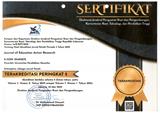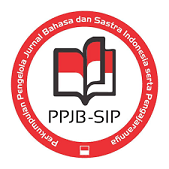PEMBELAJARAN MENULIS CERPEN DI KELAS XI IBB SMA SARASWATI SINGARAJA
DOI:
https://doi.org/10.23887/jjpbs.v5i3.8687Abstrak
Penelitian ini bertujuan mengkaji perencanaan dan pelaksanaan pembelajaran menulis cerpen di kelas XI IBB SMA Saraswati Singaraja. Ancangan penelitian ini deskriptif kualitatif dengan subjek guru bahasa Indonesia kelas XI dan siswa. Objek penelitian berupa perencanaan dan pelaksanaan pembelajaran menulis cerpen. Ada tiga metode pengumpulan data yang digunakan dalam penelitian ini, metode observasi, wawancara, dan dokumentasi. Data di analisis dengan menggunakan teknik analisis deskriptif kualitatif. Hasil penelitian menunjukkan bahwa RPP guru terdiri atas komponen-komponen seperti: identitas RPP, kompetensi inti, kompetensi dasar, indikator pencapaian, tujuan pembelajaran, materi pembelajaran, alokasi waktu, metode pembelajaran, langkah-langkah kegiatan pembelajaran, media dan sumber belajar, dan evaluasi pembelajaran. Ada beberapa kelemahan dalam RPP tersebut seperti: (1) materi pelajaran masih terlalu umum, (2) guru hanya menggunakan satu sumber belajar, (3) guru belum mencantumkan media yang digunakan. Namun demikian, secara umum pembelajaran yang dilakukan oleh guru sudah mengikuti langkah-langkah yang terdapat dalam RPP yang mencakup kegiatan pendahuluan, inti, dan penutup. Ditemukan sejumlah kelemahan dalam pelaksanaan pembelajaran seperti: (1) guru masih menyelipkan kegiatan mencatat materi pelajaran yang seharusnya dihindari dalam pendekatan saintific. (2) guru sama sekali tidak melaksanakan penilaian sikap. Pencantuman instrumen penilaian sikap dalam RPP ternyata hanya formalitas.Kata Kunci : pembelajaran, menulis, cerpen
This research aims to analyze the planning and implementation of write short stories in senior high school XI IBB SMA Saraswati Singaraja. The sujects of this qualitative descriptive study were Indonesian teachers and students in class XI. The object of this research were planning and implementation in writing short stories. There were three methods of data collection used in this study, the methods were observation, interview and documentation. Data were analyzed by using descriptive analysis techniques. The results of this study indicated that teacher’s lesson plan include learning components such as: identity of the lesson plan, core competencies, basic competencies, indicators of achievement, learning objectives, instructional material, the allocation of time, learning methods, the steps of learning activities, media and learning resources, and evaluation of learning. There were some weaknesses in the lesson plan, such as: (1) matterial was still general, (2) the teacher used only one learning resource, (3) teacher had not specified media in used. However, In general the study conducted by already following the steps that contained in the lesson plan, the preliminary activities, main activities, and clossing. There were found several weaknesses in the implementation of learning such as: (1) the teacher still noted the activites that should be avoid in the saintific approach, (2) teachers did not implement the attitude asssessment. The inclusion of attitude assessment instruments in the lesson plan just a formality.
keyword : learning, writing, short stories
Diterbitkan
2016-11-02
Terbitan
Bagian
Articles
Lisensi
Authors who publish with the Jurnal Pendidikan Bahasa dan Sastra Indonesia Undiksha agree to the following terms:- Authors retain copyright and grant the journal the right of first publication with the work simultaneously licensed under a Creative Commons Attribution License (CC BY-SA 4.0) that allows others to share the work with an acknowledgment of the work's authorship and initial publication in this journal
- Authors are able to enter into separate, additional contractual arrangements for the non-exclusive distribution of the journal's published version of the work (e.g., post it to an institutional repository or publish it in a book), with an acknowledgment of its initial publication in this journal.
- Authors are permitted and encouraged to post their work online (e.g., in institutional repositories or on their website) prior to and during the submission process, as it can lead to productive exchanges, as well as earlier and greater citation of published work. (See The Effect of Open Access)







